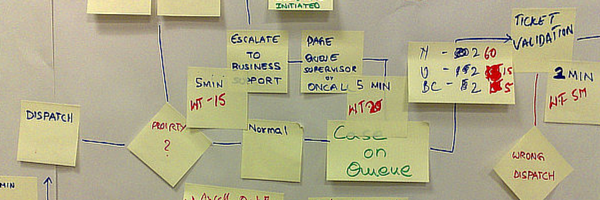This place of total absorption is what’s known as ‘the zone’ or ‘the flow’. Some think of it as a magical place where employees reach their peak performance levels and produce the best results, but what if it took a lot less than magic to help your best people to work from this place more often?
What if I told you that all it takes is four simple steps? Note: I said ‘simple’, not ‘easy’, but by tackling this step by step, it is totally doable. So, without further ado, I give you four simple steps to help your developers work in the flow:
1. Reduce Workplace Distractions

I know, I know, this one should be such a no-brainer that I don’t even need to list it as a step, but it’s a lot easier said than done!
According to a Bolt Insurance study, $134 billion dollars of US company money is spent every year on non-worked related tasks and not all of that wasted time is spent tending to fantasy football teams (despite what the infographic from the study might lead you to believe!)
Useless meetings, office politics, bad processes which lead to fixing others’ mistakes and annoying co-workers are all to blame. Distractions are the number one productivity (and flow) killer out there!
Do you know what all these time wasters have in common? They’re all aided and abetted by the open plan office which accounts for around 70 per cent of US office set-ups. This is especially true for companies who employ creatives.
We’ve all heard the arguments for these workplaces. It facilitates teamwork, creativity and transparency between the departments. Great, I’m not about to try and argue against it, but go into any open-plan office and what do you see?
People talking on the phone, other people listening to music, groups of people talking about everything and anything and the deafening sound of productivity being wasted.
So what’s the solution?
Agile methodology states that communication is the most important factor and private offices don’t really permit that. Instead, think of an office as a scrum, with groups working in smaller open-plan type rooms.
With teams of seven or eight developers, these scrums give all the creative benefits of the open-plan office, with none (or at the very least, a lot less!) of the distractions.
2. Improve team communications

Having reduced the distractions from your developer’s work environment, the next step is to combat the distractions that can occur slap bang in the middle of the coding phase.
Lack of communication between programmers leads to lots wasted time, particularly when it comes to trying to figure out what other developers in your team have already discovered. Pooling resources via great communication allows one developer to share a solution that might otherwise take his or her colleague several hours to fix.
So how can we get our developers talking to each other better and more effectively?
Instant messaging tools
Programs such as Skype, Slack or Google Hangouts can be a big help. Not only do instant messaging tools reduce the need for walking around (and disrupting!) the entire office, they allow for a written record of the conversation – perfect for referring back to instead of having to go to a colleague for a reminder of what they already told you last week!
Organization library
The easiest way to pool knowledge is via an organization library. With ‘how to’ guides and written information about processes, it’s like a documentation platform. Include a simple search engine and employees can find what they’re looking for in just a few clicks.
Building one can be as simple as creating a series of linked Google docs but if you can’t develop one for your own company, ProcessBuddy does exactly this and also has a nice progress tracker for each process.
Intranet
Intranet solutions have been around for a while now and they’re still really useful. Having a smaller version of Facebook designed for your company could be incredibly valuable to developers.
Instead of wrangling a problem alone they can instead post the issue on the company intranet and wait for colleagues who have already solved a similar issue to weigh in with an answer.
Short daily meetings
While meetings are generally regarded as the plague of the twenty-first century, quick, structured (time limited!) meetings at the start of each day can help get the pulse of the team and where it’s headed.
When I first attended a short daily meeting I was very skeptical as to how useful it could be but now I just can’t start my day without it! Having all my colleagues committing to what they’re about to do, explaining what they did and where they need help significantly increases our productivity as well as team morale.
3. Streamline workflow

Closely linked to the organization library is the idea of workflow. All too often, how we do something is designed on the run. These processes might (eventually!) get written down somewhere in a Word document and become the official standard model for getting work done but then what happens?
In most cases, despite an initial enthusiasm, they become outdated as new and better ways of working are implemented and so everyone just ignores the official model. It becomes internally accepted that they need to be improved but no action is taken.
What if every member of a team were personally responsible for providing feedback as and when something came up?
Instead of ignoring it or working around it, each team member could send information to a person responsible for updating the documentation and they in turn could update and tweak information over time instead of needing to overhaul the entire process in one go.
How does this help your developers work in the flow? Instead of ignoring or working around issues, they have a clear methodology for recording and reporting issues which in turn will allow them to get back to work more easily.
4. Reduce micromanagement

Nothing breaks the morale of the development team more than a manager who gets involved in every single little task.
“I perform better under strict micromanagement”, said no employee ever!
Not only is it demoralizing but it has the added problem of creating dependent employees who are unable to be proactive and perform tasks on their own. Managers suffer from the fatigue of having to constantly check on and help employees. Nobody is happy!
Instead, trust your team. There is a reason why you hired them. They have a skill set that is unique to them (and different to your own!) Limit the interactions only to constructive work instead of checking up on them every step of the way.
This is where the short, start of the day meetings come into their own. You participate and share what you do and what you want to accomplish daily but you can also hear your team debate its problems and where they want to be headed.
What can you do today to help your developers work in the flow?
And so there you have it; four simple (but not always easy) steps to working in the flow. Some of these steps will require more thought and planning than you can commit to right away (if your office is open plan for example) and you might look at the whole, find it too daunting and decide not to bother but don’t give up!
Helping your developers work in the flow is brilliant both for their sense of job satisfaction and your bottom line. Go back through the steps outlined and look for those ideas that you can start to implement right away. Schedule tomorrow’s quick daily meeting with the team. Assess your office layout and talk to the relevant people about possible alternatives.
Block out time for this in your calendar and make that commitment to your company. You will not regret it!
Looking for deep insights into how your customers use your product?
InnerTrends can help. You won’t have to be a data scientist to discover the best growth opportunities for your business, our software will take care of that for you.
Schedule a Demo with us and witness with your own eyes just how powerful InnerTrends can be.